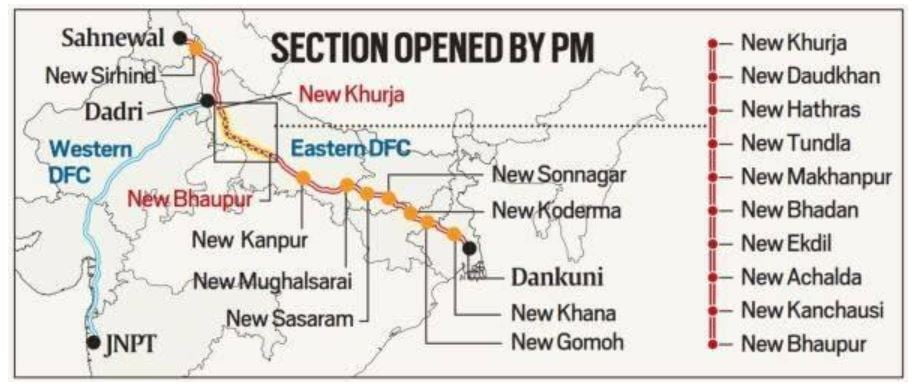All India Radio, UPSC Articles
ARCHIVES
Search 29th Decmber, 2020 Spotlight News Analysis here: http://www.newsonair.com/Main_Audio_Bulletins_Search.aspx
TOPIC: General Studies 3
- Infrastructure
In News: Prime Minister Narendra Modi Thursday inaugurated a 306-km section of the Dedicated Freight Corridor (DFC) in the Western arm between Rewari and Madar, weeks after he launched the 351-km section in the Eastern arm between Khurja and Bhaupur in Uttar Pradesh for commercial operations.
The largest infrastructure of the Railways in independent India, the DFC is an ambitious project approved back in 2006, with the aim of decongesting the railway network by laying special tracks made exclusively for goods trains.
The Project
The project, which was facing several roadblocks over land acquisition and loan approvals for over a decade, will triple the movement of goods (from approximately 25 kmph to 65-70 kmph), double the railways’ freight capacity (from 5,400 to 13,000 tonnes), and also double the length of the trains being used currently to up to 1,300 metres from the current 700 m, according to railways ministry officials.
At the same time, the DFC would reduce the high logistics cost in India, which averages from 13-15 per cent of the product cost as compared to the global average of 6 per cent.
Why was it languishing for years?
- Slow pace: The DFC was approved under the United Progressive Alliance (UPA)-I in 2006, but the first major civil contract for track construction for a stretch on the DFC was awarded only in 2013.
- Land Acquisition: Since the DFC passes through eight states, land acquisition remained slow and difficult, with state governments often not being very forthcoming. 88 per cent of the land for the project had been acquired by 2014. Yet, the capital expenditure remained very low.
- Loan Approvals: Loan approvals to fund the approximately Rs 87,600 crore project was also difficult. Eventually, after extensive negotiation, the World Bank gave a loan of around Rs 13,578 crore for the project, and the Japan International Cooperation Agency (JICA) agreed to provide a loan worth Rs 37,960 crore.
- Conversation with States: Moreover, there are other issues which are encountered at the level of states.
Significance of the Project
The Eastern Freight Corridor arm (1,839 km) starts from Ludhiana (Punjab) and passes through the states of Punjab, Haryana Uttar Pradesh, Bihar and Jharkhand, to terminate in Dankuni (West Bengal).
The Western Freight Corridor arm (about 1,500 km) starts from Dadri in Uttar Pradesh and goes to Jawaharlal Nehru Port in Mumbai, passing through UP, Haryana, Rajasthan, Gujarat and Maharashtra.

The project’s significance lies in the fact that once fully operational, 70 per cent of the goods trains will shift to the DFC, thereby freeing up the existing tracks entirely for passenger trains.
The Indian Railways carries the fourth highest tonnage of freight globally — at over 1,200 million tonnes — which includes coal, steel, petroleum products, iron ore, cement, fertilisers, foodgrains and containers.
While there has been a jump of over 700 million tonnes of freight in India in the last decade and a half, there has not been a corresponding increase in the loading capacity of the trains.
For example, while the Golden Quadrilateral corridor, which connects Delhi, Kolkata, Mumbai and Chennai carries 58 per cent of India’s freight, it accounts for just over 15 per cent of the total length of the Indian Railways network.
As a result, a large part of the freight movement in India takes place through road transport, which raises the logistics cost of goods. According to the draft National Logistics Policy, the reason for a higher than global average logistics cost in India is that 60 per cent of transportation activities are conducted via road.
While the railways has undertaken a series of measures to attract road traffic — last year, it decided to set up Business Development Units at all zonal and divisional levels to stay in touch with industries and advertise the willingness of Railways to attract new streams of traffic — the DFC remains the most crucial aspect of this endeavour.
Since these freight corridors will be exclusively meant for goods trains, they will have one station every 50 km as compared to the existing railways, which has one every 10 km. This would mean that the cost of manpower, maintenance and operation for the DFC will be much lower.
Once fully functional, the DFCs will carry the cargo carried by 1 lakh trucks in a single day, proving to be a game-changer. However, the trains will be able to run at their actual speed — envisioned at around 80 kmph — only once the project is complete.
The western corridor will bring new opportunities to farmers, industrialists and traders
Since the corridor will cover 133 railway stations in nine states, at these stations, new multi-modal logistics parks, freight terminals, container depots and parcel hubs will also come up.
Freight trains plying on this section from now on will help decongest the existing Kanpur-Delhi main line of Indian Railways, which currently handles trains at 150% of its line capacity. This section currently has over 50 passenger trains and around 60 goods trains jostling for paths daily. The new section means on the Indian Railway main line, more passenger trains can be pumped in and those trains can, in turn, achieve better punctuality.
Foodgrain and fertilisers from the northern region are transported to the eastern and Northeast regions. From East and Northeast, coal, iron ore, jute and petroleum products are transported North and West.
Connecting the Dots:
- Dedicated Freights Corridors are aimed at bringing speed with efficiency in transport sector. Discuss the challenges in laying out planned DFCs in India.
- Essay: Less of government and more of governance














